
Scrum board in Project Management: how to use it, examples and best practices
What is a Scrum board? Learn how to use it in Agile projects, see real-world examples, and explore best practices for maximum efficiency.

R&D project management is one of the most complex tasks you may encounter as a Project Manager. While in more ‘traditional’ projects, so to say, the objectives to be achieved and well-defined schedules, budgets and resources are clear from the initial stages of the project, this rarely happens with this type of project.
R&D projects rarely have such a rigid structure, but rather live in uncertainty throughout the project life cycle. Changing market needs, new opportunities to be exploited, constant adjustments in product development and resource allocation. There are so many changing circumstances in this type of projects and so many interests involved that in the end many of them fail because they end up losing focus on what is most important in this type of initiatives:
Do you currently manage R&D and new product development projects? Would you like to know what are the key elements and best practices to take the management of this type of projects to the highest level? If so, read on.
Project management consists of a set of frameworks and processes for planning and managing the different phases of a project. This is, broadly speaking, a classic definition of what is nowadays understood as Project Management in which you, as Project Manager, plan, prioritize and supervise the different operations and tasks to be carried out to complete the project within the agreed deadlines and budgets, optimizing to the maximum issues such as resource management or project costs.
However, can this traditional view of project management be applied, for example, to the research and development of new products or services? Is it possible in this type of projects to work with well-defined objectives, requirements, deadlines and budgets from the beginning, as it is the case with the projects you normally manage in your organization?

NEW PRODUCT DEVELOPMENT
Streamline your R&D project management processes
Learn more about Triskell Software’s New Product Development solution.
The answer is NO. If there is one thing that defines R&D projects, it is their high degree of uncertainty. Think about it for a moment. Most of these projects consist of researching and developing entirely new products that address a specific user need for which there is nothing available on the market.</p<
These are projects that, if well-executed, can give companies a great competitive advantage. But its management is complex, as the definition of the following aspects may change throughout the project life cycle:
PPM SOFTWARE CHECKLIST
A Comprehensive buyer’s checklist for PPM Software
Use this quick checklist to compare potential modern PPM solutions in order to pick the best one for your organization.
Due to all these constraints, the research and development of a new product brings with it governance and management challenges that, although they may have similarities to those you have to deal with in your day-to-day project management, have their own peculiarities.
For efficient R&D project management, it is necessary to know which are its key elements. Understanding these differentiating elements will enable you to better manage all the issues you will encounter throughout the project life cycle, and will increase the success rate of the research and development projects you manage. These key aspects are as follows:
We will now analyze each of them.
SUBSCRIBE TO OUR NEWSLETTER
Get stories like this in your inbox
It is important to know in detail the environment in which R&D projects are planned and developed, as it is one of the most turbulent and volatile environments that you will encounter as a project manager. You will face governance and management challenges that will be difficult to respond to immediately due to the complexity and uncertainty surrounding these new product development projects. Some outstanding examples:
Knowing how to manage an environment in which executives, teams and external partners can influence the development of the project will be the biggest challenge you will face as an R&D project manager.
WEBINAR
Agile vs Phase-Gate: Choosing the right path for new product development
Customer involvement in the development of new products is key. Their feedback will not only allow you to develop products that are easy to use and maintain, but also to identify improvements in aspects such as usability, product performance and satisfaction of consumer needs. Feedback that, if used wisely, will help to achieve greater market penetration of the products and, therefore, more profits for the company.
It is recommended to involve the customer in several of the phases of the R&D project life cycle, such as:
Customer feedback will allow identifying improvements in the usability of the product and the satisfaction of the consumer’s needs
It is recommended to involve the customer in several of the phases of the R&D project life cycle, such as:
The active involvement of the client in the development of R&D projects means that the management of the requirements of this type of initiative has some peculiarities compared to other types of projects. While it is normal to have clear project requirements in the early stages of a project, this is not the case when it comes to new product development.
The requirements for this type of project tend to evolve over time. And the lack of agility and flexibility of organizations to adapt to this type of circumstances, very common in R&D projects, causes many of them to fail. An efficient management of these requirements and a clear communication of any changes in them will be critical to manage key aspects of these projects such as resource management, capacity planning or project budgets.
Project stakeholders should not lose focus on the strategic objectives
Therefore, when managing project requirements, it is essential that all project stakeholders (project managers, development teams, external partners, executives, etc.) never lose focus on the strategic objectives and overall purpose of the R&D project.
Most R&D projects are large-scale, involving the allocation of multiple organizational resources to perform the various tasks of the project throughout its life cycle.
If we add to this what we have already mentioned in the previous point regarding the complexity of managing the requirements of an R&D project, you will now understand the importance of resource management and capacity planning for this type of initiatives.
WEBINAR
How to manage resource constraints in a multi-portfolio environment
When managing R&D projects, it is essential to have a communications plan in place that establishes the following:
Considering how quickly requirements can change and, above all, the uncertainty that always surrounds R&D projects, having a clear understanding of how all project changes will be communicated is essential for efficient project management.
You must put in place a project communications plan for efficient project management
Now that you know the key elements that differentiate R&D project management, it is important that you implement a series of best practices to increase the probability of success in the development of new products. Some of them will be familiar to you because you are probably already putting them into practice in other types of projects, but in R&D and new product development are especially relevant. They are the following:
When managing R&D projects, it is essential that all parties involved never lose focus on the strategic objectives of the organization. Hence, if there are changes in factors such as priority, requirements, budget or project deadlines, you can make decisions aligned with the vision and mission of the organization.
Having processes and tools in place that allow you to plan What-if scenario simulations will be critical to managing budgets, costs and other factors will be key to the efficient management of your new product development projects.
See how Triskell can empower your R&D teams
Schedule a demo today and discover how Triskell can help to collaborate effectively and bring innovative products to market faster.
Dealing with all the workload involved in new product development is one of the biggest challenges any project manager has to face, especially when it comes to resource management. If it is already complex to plan the allocation and management of resources in any type of project, program or portfolio, this becomes even more complicated when you enter the R&D field.
Again, the uncertainty surrounding these initiatives is the cause of this. Depending on the type of R&D project you may have tighter schedules, while in others you may not have any deadlines for each of the project milestones.
You should plan in advance the resources you will need for the project
What-if scenario simulations are essential to keep project objectives and requirements aligned at any time. But also, with the strategic vision of the organization, they become even more relevant for resource management. It is key to the process to be able to plan in advance the resources you will need for the project based on how the priority, requirements and deadlines of the project evolve.
R&D project management requires the implementation of rigorous control processes to review the progress of the project and make the corresponding adjustments when necessary. There is no point in devoting resources, money and time to a new product that, once finished, does not meet the needs of customers and markets because we have not been exhaustive when it comes to periodically reviewing what has been done.
Therefore, the Phase-Gate methodology is best suited to the R&D project environment. This methodology mainly consists of implementing a review process for each of the phases of the project (ideation, scope, business case, development, testing and launch), in which, after having analyzed the progress made and identifying possible improvements to be implemented, one of the following decisions is taken:
In an R&D project, the documentation process takes on special relevance, more than in any other type of project. Not only the progress made should be documented, but also any changes that may have occurred in the project (new requirements, budget and resources adjustments, updated deadlines, etc.) and the reasons why these changes have been made.
All communications with project stakeholders (minutes, e-mails, reports, presentations, etc.) shall also be recorded.
All changes to the project and the reasons behind them should be documented
All this documentation will serve as a knowledge base not only for the current project, but will also serve as a repository for future R&D projects to be managed and as a source of learning from past successes and mistakes.
Due to the importance of R&D projects and new product development for organizations, communication with stakeholders must be regular and smooth.
From the initial stages of the project, you should establish a frequency with which to communicate with them. These are communications that will go beyond reporting on the progress of the project, since you must agree with them on aspects such as:
As indicated in the previous point, all communications with stakeholders must be documented for proper monitoring of the project’s progress.
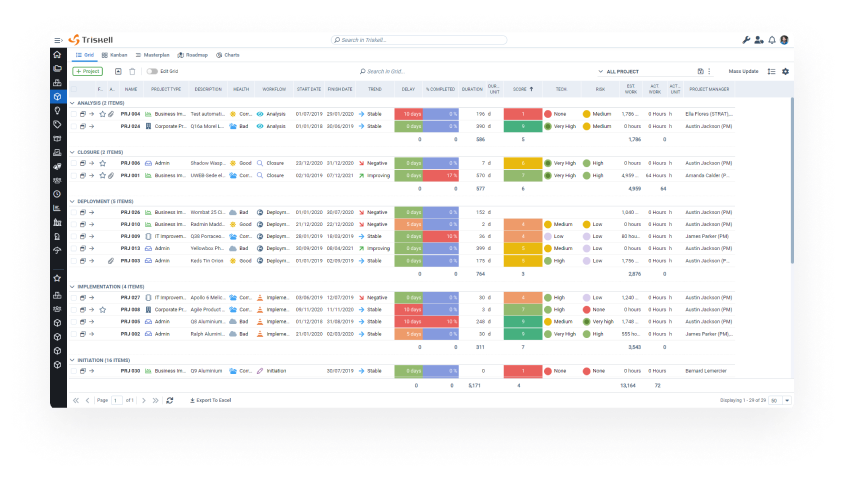
If you think that by filling in spreadsheets you will be able to manage your R&D projects, get that idea out of your head because this type of project is much more complex than any other you manage in your organization. A traditional project management tool is also not enough to cover many of the governance and management challenges involved in new product development, as these tools do not efficiently cover issues such as planning and strategic alignment.
A PPM software is the best option to take R&D project management to the next level. With a PPM tool you will be able to:
The Triskell platform is the PPM software with strategy execution management functionalities that will allow you to successfully address all the challenges and difficulties you will encounter when managing your R&D projects. Thanks to its flexibility and ability to integrate with different tools (e.g. ERP software, Jira or Microsoft Project) you will be able to plan, monitor and manage all aspects of your R&D projects.
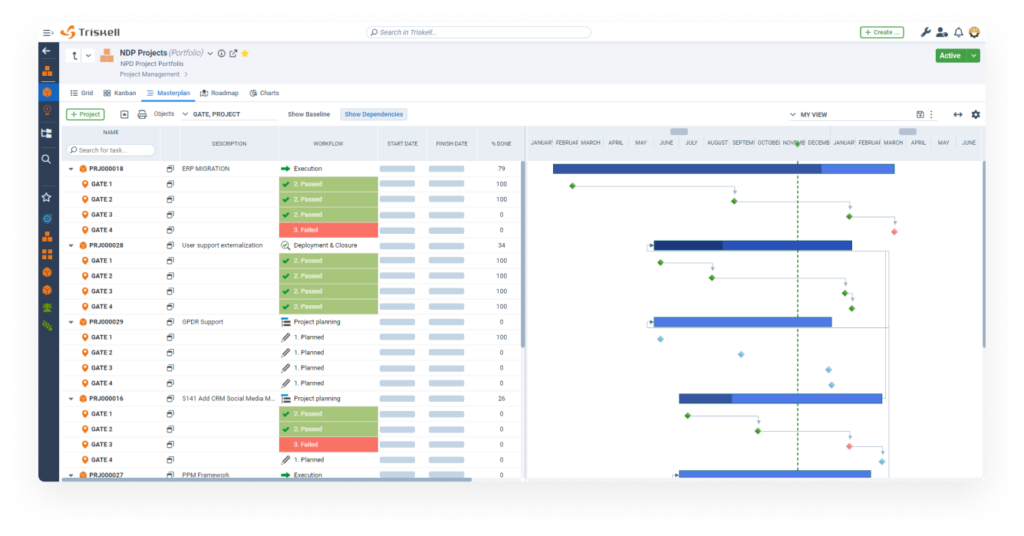
Here are some of Triskell’s features that will help you to achieve excellence in R&D project management:
SUBSCRIBE TO OUR NEWSLETTER
Get stories like this in your inbox
Request a demo of Triskell Software
If you would like to learn more about how Triskell can help you manage your organization’s R&D projects, request a demo below.
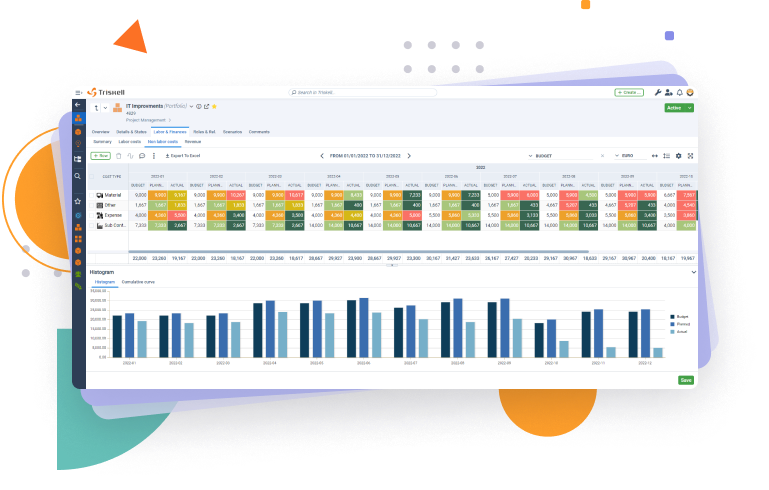
The biggest challenges of managing R&D projects stem from their inherent uncertainty. Unlike traditional projects with well-defined goals and deliverables, R&D projects often involve exploration and discovery. This makes it difficult to predict timelines, costs, and even the final outcome. Additionally, R&D projects often require flexibility and adaptation as new information or challenges arise.
Ensuring your R&D project aligns with business objectives requires constant focus and communication. Here are some key steps:
Phase Gates are decision points implemented throughout the R&D project lifecycle. At each Phase Gate, a project team evaluates progress against pre-defined criteria. This evaluation determines whether the project moves forward to the next phase, requires replanning, or needs to be terminated.
Phase Gates benefit R&D project management by:
Capturing and documenting learnings throughout an R&D project is crucial for future success. Here are some best practices:
Related Content

Scrum board in Project Management: how to use it, examples and best practices
What is a Scrum board? Learn how to use it in Agile projects, see real-world examples, and explore best practices for maximum efficiency.
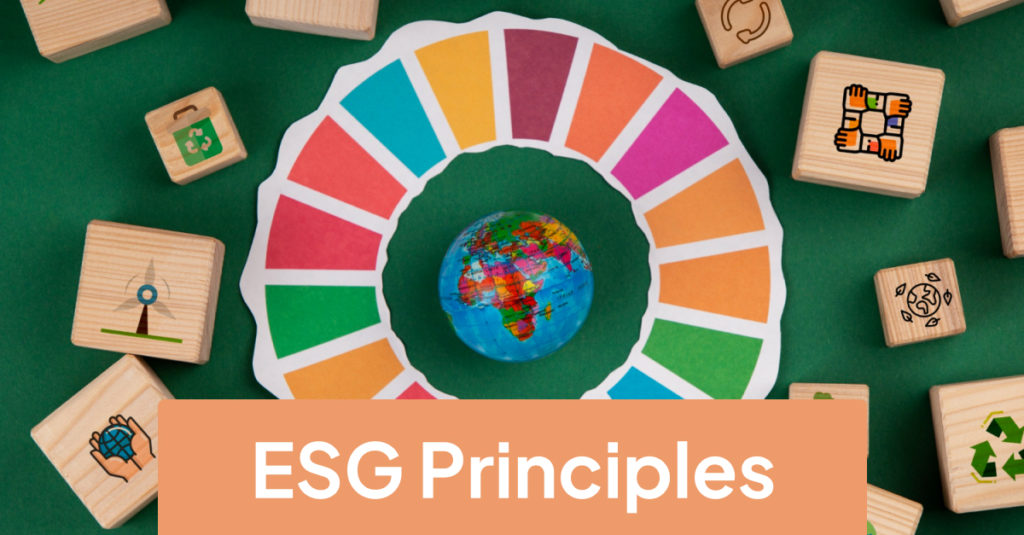
ESG principles, frameworks and best practices for Project Management
Align projects with ESG principles. Learn how companies use frameworks like GRI & SASB to meet sustainability goals and improve compliance.

10 types of Project Management Offices (PMO): structure, purpose and how to choose the right one
Learn about different PMO types, their governance levels, and which one is the best fit for your company’s project management needs.
Solutions
Platform
Company
Compare Triskell
© 2025 Triskell Software. All Rights Reserved.
Legal Notice
Privacy Policy
Cookies policy
Quality Management and Information Security System Policy

We use technologies such as cookies to store and/or access device information. We do this to improve the browsing experience and to display (non-) personalized advertisements. Consenting to these technologies will allow us to process data such as browsing behavior or unique ID's on this site. Not consenting, or withdrawing consent, may adversely affect certain features and functions.
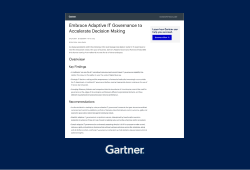
Embrace Adaptive IT Governance to Accelerate Decision Making
Traditional IT governance is holding businesses back. This Gartner report introduces a flexible, outcome-driven governance model designed for speed, agility, and enterprise-wide impact.
Download now and learn how to modernize decision making across your organization.